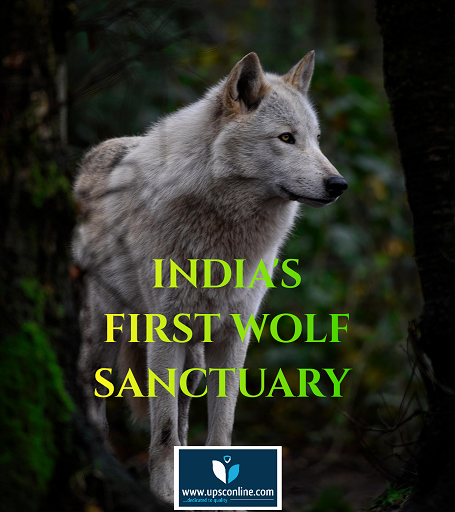Large carnivores worldwide are experiencing a significant decline, primarily due to habitat destruction and deliberate persecution by humans. Although extinction is primarily a demographic process, influenced by changes in mortality & fertility rates that lead to a decline in population growth.
Consequently, the study of breeding sites, which directly contributes to understanding species demography, is crucial for the formulation of effective population management programs
The wolf population in India is around 3,100 individuals in the wild. Extensive habitat loss due to human expansion and retaliatory killings have significantly contributed to the decline of wolf populations throughout their range.
The Indian Wolf Canis lupus pallipes is found in various habitats, mostly human-dominated areas. They are social animals and use dens and rendezvous sites for rearing pups.
Wolves survive with humans because of their ability to exploit human-modified landscapes (Habib, 2007). However, they also prey upon livestock, allowing the potential for conflict, especially with the shepherd community (Singh & Kumara, 2006).
Coexistence may be vital for the conservation of this species, while co-adaptation is essential for promoting peaceful relations between humans and large carnivores. Promoting coexistence requires managing the complex interactions between people and wildlife.
Moreover, tribal traditions and cultural practices can play a pivotal role in understanding coexistence mechanisms and contribute to species conservation, such as that of the wolf. Many tribes follow practices like totemism, which fosters the protection of biodiversity by revering certain species and habitats as sacred
Such belief systems, which incorporate taboos and spiritual connections with the land, promote the conservation of flora and fauna, some of which are endangered or threatened. Jharkhand, with its rich biodiversity and significant tribal population (26.3% of the state’s total), exemplifies this connection between indigenous cultures and conservation.
The region’s tribal communities adhere to taboos that prevent the exploitation of natural resources, ensuring the regeneration and protection of forests and creating spaces for wildlife to thrive.
These traditions create disturbance-free zones that wildlife can utilize, indirectly supporting ecosystem stability and biodiversity. Wildlife managers throughout the wolf range, particularly in heavily populated nations such as India, encounter considerable difficulties in reducing human disturbances.
Interestingly, this is not the case in the Mahuadanr Wolf Sanctuary, where the Sal tree (Shorea robusta) dominates, and interestingly, the local tribal people, who worship the tree, strictly avoid entering the forest during winter until the Sal flowers begin to bloom.
Human disturbance at wolf dens and rendezvous sites continues to be a concern. However, the influence of cultural factors on wolves den site selection remains understudied and needs further exploration.
Additionally, den sites are a vital component of wolf ecology & gaining insights into how wolves select these locations is crucial for wildlife managers to make informed decisions about their management and conservation.
Dens are vital for the survival of wolf populations, serving as a limited resource for some groups. The stable microclimate provided by dens is particularly important for the survival of young pup.
Another significant factor is the topography of canid den sites, which plays a role in predator avoidance. It is essential to understand the topographical characteristics of den sites, as most pup mortality happens within the first six months of life.
The placement of dens affects the susceptibility of both pups and adult wolves to predators. Topographical features, particularly slope, are considered “energy-expensive terrains” where movement incurs higher energy costs due to the effects of gravity, as compared to flat terrain.
In response to inclined surfaces, animals tend to adopt energy-efficient movement strategies, such as altering their speed, direction, and avoiding steeper slopes. This behaviour allows wolves to access relatively safer areas by utilizing their long-term understanding of how competitors use the space.
There is a lack of research dedicated to understanding the energy-efficient movement patterns of large carnivores in India, particularly concerning slope.
This aspect is vital to denning ecology and could provide important insights into the factors influencing den site selection, especially regarding interspecific competition.
The MWS is situated in the Mahuadanr block of Latehar district, an area largely populated by tribal communities more than 80 per cent of whom follow “Sarna Dharma”.
The cultural practices of the local tribes, particularly their avoidance of the Sal-dominated forests during winter—coinciding with the wolves’ breeding season. Along with the area’s topographical features, there are two other factors considered as important in the wolf conservation .
1.Wolves preferentially select den sites located in areas with challenging topographical features, which are energetically demanding for other predators to access. This selection behavior reduces the likelihood of encounters with co- predators, thereby increasing the survival chance of the wolves.
2.The Sal Forest serves as a refugia for wolf den sites as tribal people avoid entering these areas during winter, resulting in a disturbance free zone that enhances the suitability of the forest for denning.
Most of these den sites are located between 501 and 1000 m from the nearest human settlement & within 501 to 1500 m from the nearest water source. The combination of Sal abundance, slope, and average shrub cover yielded the best fit.
Dens serve as central hubs within a wolf’s home range, playing a crucial role in vital activities such as feeding and breeding, both of which are fundamental to the species’ survival.
According to khan et al.,most dens were located in grasslands and were burrowed into the ground in Maharashtra. But in Mahuadanr, all the dens in our study area were located in rock caves, and no burrows were found to be occupied by wolves.
This variation could potentially be attributed to the differences in habitat types between the two regions. However, many species show a preference for rocky refugia, which are considered to provide advantages over burrows. Unlike burrows, which are susceptible to flooding and structural damage, rocky refugia remain dry, retain their structure, and offer a more stable microenvironment.
The smaller openings may facilitate easy escape for wolves while making it more difficult for larger predators to enter the den. Human presence, often described as the “super-predator,” can induce fear and avoidance behaviours even in large carnivores, leading to shifts in their behaviour to minimize risky encounters.
Mahuadanr is having a badland topography and was a wasteland. The Quest for bauxite in the bordering areas of Chhattisgarh-Jharkhand poses a threat to the future of the Mahuadanr Wolf Sanctuary.
Bauxite mining started in Jharkhand’s Orsa village, approximately 2.5 kilometres from the wolf sanctuary, in 1986 over an area of 309.36 hectares. Initially, the lease was granted till 2006 but was extended in 2017 on about 196 hectares of non-forest land till 2036.
In 2019, the final ESZ specifying the extent of the ESZ around the sanctuary was notified by the Indian government’s environment ministry. But the locals from Orsa stood against mining.
Spread over an area of 63.256 square kilometres and about 194 km from the state capital Ranchi, the sanctuary is in the Latehar district of Jharkhand. The wolf sanctuary is also home to sloth bears and has a healthy population of leopards as well.
The final ESZ declaration is limited to Jharkhand but mining is continuing in Chhattisgarh in the bauxite mines of Hindalco that are operational over an area of 3,741 ha. This mining is also affecting the flow of the perennial Burha river.
The Burha river after entering Jharkhand flows from near the Orsa village and then passes through the middle of the Palamau Tiger Reserve (PTR) and is considered its lifeline. In Orsa, though the mining has stopped the abandoned pit is still lying open, posing a danger to humans as well as animals living nearby.



0 Comments